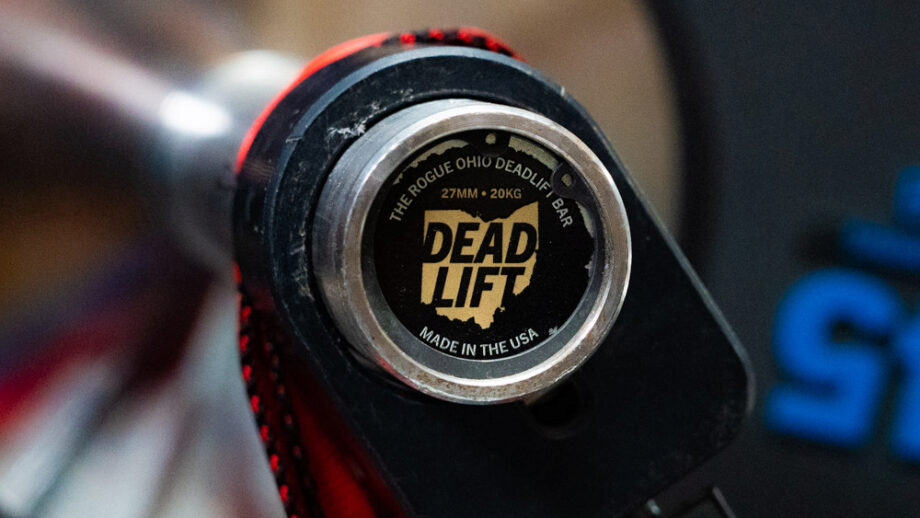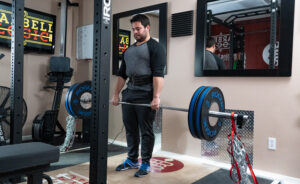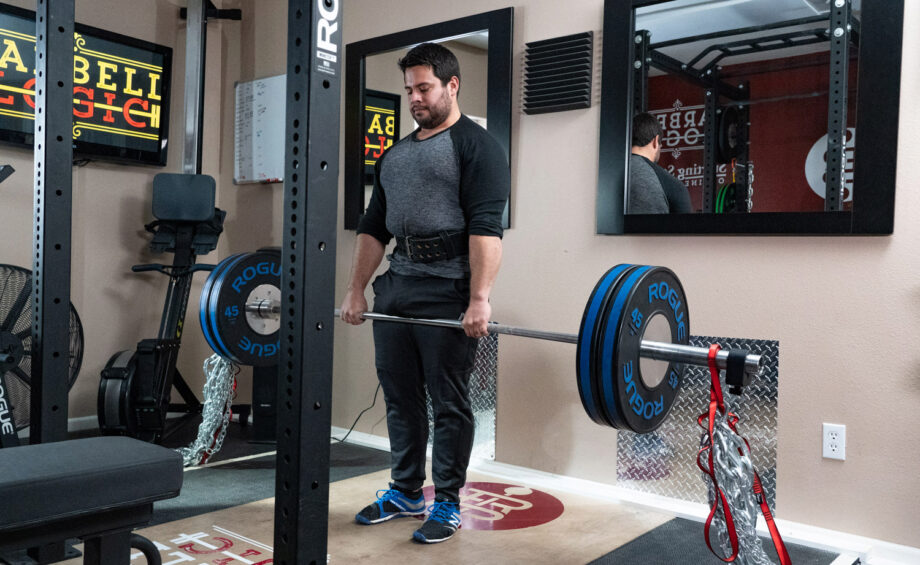We test and review fitness products based on an independent, multi-point methodology. If you use our links to purchase something, we may earn a commission. Read our disclosures.
The Rogue Ohio Deadlift Bar is the best value deadlift bar currently available. Not only is it one of the cheapest true deadlift bars on the market, but it’s also one of the best. Combining great attention to detail, a consistent and aggressive knurl, and a slinky 27MM shaft, the Rogue Ohio Deadlift Bar is the deadlift bar we most often recommend to those wanting to add a dedicated barbell for deadlifting to their gym.
Rogue Fitness
Rogue Ohio Deadlift Bar

Pros & Cons
Bottom Line
Rogue Fitness is known for making some of the best and most well-liked barbells in the world. Not only are they supremely crafted, but they’re also priced at a great value, even compared to bars that don’t have nearly the specs as they do. The Ohio Deadlift Bar is a perfect example of this concept. Although cheaper than just about every other deadlift bar on the market, it’s still one of, if not the best deadlift bar available. The knurling is a volcano-type knurl as seen on the ever-popular Rogue Ohio Power Bar, the shaft is available in multiple coating options, the sleeves use bronze bushings (the Okie Bar uses no bushings) and it’s all available for over $100 less than the competition when shipping is considered, oh and I forgot to mention, it comes with a lifetime warranty to boot. This is without a doubt the deadlift bar we’d recommend to most people.
What is a Deadlift Bar?

The sport of powerlifting consists of three different barbell lifts: the squat, the bench press, and the deadlift. In the beginnings of the sport of competitive powerlifting, all three lifts were performed using the same barbell. But then the 1980s came and a man by the name of Rickey Dale Crain decided to change the game…and by that I mean, he invented the first deadlift bar.
Crain’s Okie Deadlift Bar was a first of its kind and was originally sold as the Oklahoma Deadlift Bar upon it’s release in 1984 (fun fact, the bar has remained pretty much unchanged since that time.) Similar in appearance to a normal power bar, but designed specifically for one job: to give the lifter the potential to deadlift more weight. Crain accomplished this subtle feat of engineering with a few specific changes to the overall structure of the power bar.
For starters, a deadlift bar utilizes a thin shaft (relative to a power bar.) The shaft diameter of the Okie Deadlift Bar (what we presume is the deadlift bar standard) was, and currently is still today, 27MM. A typical power bar ranges between 28.5MM and 29MM. This may seem like a minor change, but anyone pulling above 500 LB could recognize what a difference this makes. A slightly thinner shaft allows the lifter to maintain a more secure grip as more of their finger can get around the bar. The 27mm seems to be a perfect diameter for most lifters when it comes to a deadlifting bar. Anything larger – there’s nothing special in regards to a better grip. Anything smaller – it may feel as if the bar would cut through your fingers at the interphalangeal joints.

The second aspect of the optimal 27mm bar shaft is that it is also longer than a typical barbell. With the deadlift bar being thinner and longer, this adds substantial whip and flex to the bar during the pull. This enables the lifter to pull any slack out of the barbell at the beginning of the pull, perhaps even making the actual deadlift resemble something closer to a very low pin rack pull (which makes it feel as if it is easier to pull the bar off the floor).
The last feature of the deadlift bar is the knurling. The knurling used on deadlifting bars is usually described as being sharp and grippy. We have discussed before that knurling is a more subjective feature of a barbell and greatly depends on preference. Some deadlift bars we have used are very sharp, almost razor like (such as the Okie Deadlift Bar). Some try to play the line better, as we have found with the Rogue Ohio Deadlift Bar.
RELATED: Deadlift Muscles Worked
What We Like About the Rogue Ohio Deadlift Bar

The Rogue Ohio Deadlift Bar, as with most Rogue Bars, is likely one of the most popular and purchased deadlift bars in the world. The Ohio Deadlift Bar from Rogue has been out for a bit, but we’ve only had short encounters with the bar up to this point. Once we got our hands on it, the first thing we noticed was the plating, or rather, lack thereof. The Ohio Deadlift Bar that we tested was a raw steel version, which is priced at $310 as of this writing. There are other versions available, both with a zinc or Cerakote coating. We really like raw steel for a deadlift bar due to the knurl being the sharpest it can be, however, it must be expected for the bar to patina over time, especially in a garage gym.
Grasping onto the Ohio Deadlift Bar, we became very pleased with how it felt. The knurling Rogue uses is very similar to the knurling on the Rogue Ohio Power Bar, although it does feel a bit sharper. Perhaps the largest reason for it feeling different is due to the smaller diameter of the Ohio Deadlift Bar. A true 27MM diameter is used (as seems to be standard with deadlifting barbells). This makes the knurling feel slightly sharper in our hands and seemingly more grippy.

The Rogue Ohio Deadlift Bar knurling can be described as being the volcano style. This style of knurl creates an appearance of tiny volcanoes throughout the shaft of the barbell, less the very center 17” of the bar which is free of any knurling. Deadlift bars utilize no center knurl as it is not needed and could actually hinder the lifter. The Rogue Ohio Deadlift Bar has no knurling in this middle 17” area, so conventional deadlifters shouldn’t worry too much (unless you have a strongman-type grip and foot width) about the tiny volcano knurls shredding up their shins.

The volcanoes are formed by taking an additional pass during the knurl scoring process, chopping of the peaks of the mountains that were formed during the first couple of passes. A benefit of Rogue’s volcano knurl is that it allows the lifter more contact surface area with the epidermal layer of their hands. Since you’ll be gripping to circular edges of a volcano instead of to just one mountain peak, you have more contact with bar in your hands.
A bar with a mountain peak style of knurl can often feel too sharp and can actually cut through the skin. We have found the volcano style, while still maintaining a very grippy feel, does not have this problem. Also, (four times as many as would be if the tops of the peaks weren’t chopped off) you don’t need as “sharp” of a knurl. This leads to a greater grip and less ripped calluses and blood on the platform.

With the Rogue Ohio Deadlift Bar in hand and our bodies moved around to the deadlift position, we pull the bar from the floor and find that smoothness of pull that can only be found on a deadlifting barbell. The Ohio Deadlift Bar we found really allows you to smoothly pull the slack out of the bar to the point that once the plates break from the floor, you almost feel as the bar is slightly assisting you during the lift. As stated earlier, the diameter of the bar plus the overall bar length (90.5”) allows there to be more whip in the barbell itself. Another characteristic we think Rogue uses to help out with this is their choice in going with a shaft made of 190K PSI Tensile Strength Steel.
As can be seen on the continuum of steel ratings (this is Rogue’s opinion,) this places the Rogue Ohio Deadlift Bar in the ideal zone but slightly more towards the bendy side. Although a bendy bar is less than ideal for a bar used for the squat and bench, it often allows more weight to be lifted for the deadlift. This said, too bendy of a bar can be difficult to control as seen at the Arnold Strongman Classic which utilizes the extremely slinky Elephant Bar.

Even though this is a deadlift bar, we see that the barbell is still strong enough to receive a F2 rating on Rogue’s F Scale. Barbells rated at F2 can handle a high level of use and can last a long time in any garage gym or even a powerlifting-focused gym that sees a variety of strength levels (although we wouldn’t suggest using the bar for rack pulls unless it’s your only option.
Even if for some reason the Ohio Deadlift Bar had something wear out with usage (or it bends during normal use) Rogue offers a lifetime warranty that is known to be one of the best and most encompassing in the industry.This said, using the bar for rack pulls and dropping it on the pins will likely not be covered.
The Rogue Ohio Deadlift Bar is definitely a standard in itself. It feels great in hand, is manufactured consistently, and engineered to handle heavy deadlifts. Although we certainly think there are many other pieces of equipment that we’d recommend before purchasing a deadlift bar, if you’re in the market for one, this is our recommended option.
Here is a quick recap of the specs:
| Plating | Black Zinc w/ Bright Zinc (sleeves) | Bare Steel |
| Price | $355.00 | $310.00 |
| Weight | 20kg (44 LB) | 20kg (44 LB) |
| Diameter | 27mm | 27mm |
| Bar Length | 90.5” | 90.5” |
| Sleeve | 15.5” (Bushing) | 15.5” (Bushing) |
| Knurling | Volcano | Volcano |
| PSI Tensile Strength | 190K | 190K |
| F Scale Rating | F2 | F2 |
| Warranty | Lifetime | Lifetime |
Rogue Ohio Deadlift Bar vs Texas Deadlift Bar vs Okie Deadlift Bar

When it comes to the deadlift bar market, we believe the Rogue Ohio Deadlift Bar is the best deadlift bar we have tested, both in function as well as value cost. On paper, each of the deadlift bars we have tested seems very similar, but the Rogue Ohio Deadlift utilizes a more consistent knurling and is priced way better.
Since Rogue is a much larger company with a manufacturing plant to match, they are able to produce high-quality barbells at a much lower cost compared to most competitors with smaller operations.
Since we talked about Crain’s Okie Deadlift Bar history so much in the beginning, we will start the comparisons there. The Okie Deadlift Barbell is very similar to the Rogue Ohio Deadlift. There are many differences between the Okie and Ohio Deadlift Bars even though they may look the same when next to each other. We reviewed the Okie Deadlift Bar in depth, you can find that here, and although it was a good bar when it was released, it has pretty much remained unchanged since that time a few decades ago. The tensile strength for the Okie is not listed, but we would assume that it would be around 175K (which would place it slightly out of the optimal zone on the bendy side of the barbell strength continuum).

The Okie Deadlift Bar is more expensive than the Rogue Ohio Deadlift Bar, priced at $399 (which $90 or $45 more, depending on the Rogue plating that you choose). The Okie knurling is very aggressive and we would consider sharper than the Ohio Deadlift Bar. To be honest, we were surprised just how sharp the Okie Deadlift Bar was when we pulled it out of the tube. Not only was it sharp, but there were still a ton of metal shavings still on the bar that were never brushed off before being delivered. While many lifters would find this as a slight plus, we believe that too sharp of a barbell could actually be a hindrance to your grip. Also, the risk of tearing a callus is greatly increased without adding much benefit.
Even more similar to the Okie Deadlift Bar is the Buddy Capps Texas Deadlift Bar. The Texas Deadlift Bar is Black Zinc as well, but you also have the option to pick it up in a chrome finish. Chrome would not be the wisest of choices however, since chrome is slicker in feel, plus isn’t the best plating option for a barbell.
The knurling of the Texas Deadlift Bar is more similar to the Okie than it is to the Rogue and similar remarks can be stated as in the previous paragraph.
The Texas Deadlift Bar is priced at $413, which is over $100 more than the Rogue Ohio Deadlift Bar (the bare steel version). As stated, the Texas and Okie deadlift barbells are most likely priced higher due to them not having as equipped of a barbell manufacturing operation when compared to Rogue Fitness in Ohio and just a choice to price in such a manner partly because they had no competition up until a few years ago.
Full Rating
Rogue Ohio Deadlift Bar

The Rogue Ohio Deadlift Bar is the best value deadlift bar currently available. Not only is it one of the cheapest true deadlift bars on the market, but it's also one of the best. Combining great attention to detail, a consistent and aggressive knurl, and a slinky 27MM shaft, the Rogue Ohio Deadlift Bar is the deadlift bar we most often recommend to those wanting to add a dedicated barbell for deadlifting to their gym.
Product Brand: Rogue Fitness
Product Currency: USD
Product Price: 390
Product In-Stock: InStock
4.7
Rogue Ohio Deadlift Bar FAQs
Is the Rogue Ohio bar good for deadlift?
The Rogue Ohio Deadlift Bar is unquestionably a benchmark. It has a wonderful feel in the hand, is well-made, and is designed to withstand hard deadlifts.
How much does the rogue Ohio deadlift bar weigh?
20KG
Is the Ohio Bar good for deadlifts?
The knurl pattern on the bar is deep and coarse without being sharp or abrasive, and the 29MM shaft diameter and high tensile strength result in little flex and whip. As a result, the Ohio Power Bar is a well tuned workhorse for benching, squatting, and deadlifting.
RELATED: Best Deadlift Shoes
Where to Purchase
Rogue Fitness
Rogue Ohio Deadlift Bar

Pros & Cons
Bottom Line
Further reading

Our Bloom protein review breaks down the formula, cost, and competition to help you decide if Bloom Whey Protein Isolate Powder is right for you. Read more

If you’re here to get your recovery in natural scenery, you’re in luck; here are our expert-tested selections for the best outdoor saunas. Read more

Is your fitness routine getting stale? Challenge yourself with our 28-day workout challenge with progressions and accountability built right in. Read more

Is this “super advanced” protein the secret to building muscle? Our Body Fortress Whey Protein review holds the answer. Read more

